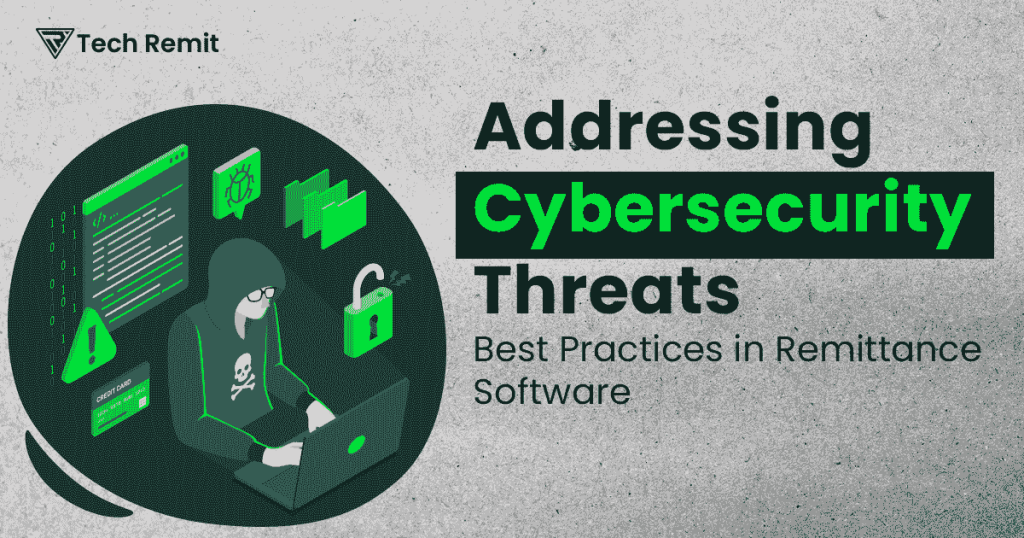Addressing Cybersecurity Threats: Best Practices in Remittance Software

In today’s digital world, cybersecurity acts as a crucial element in building trust and reliability within remittance software. It is essential to prioritize secure operations in the remittance industry due to its responsibility for managing large quantities of sensitive financial information and facilitating international transactions. It has a higher chance of facing challenges such as unauthorized access, data breaches, and financial fraud.
This article explores the concept of cybersecurity and the best practices that can effectively protect these systems. The article further discusses strategies such as encryption, multi-factor authentication, regular security updates, and user education.
Cybersecurity Threats in Remittance Software: A Deep Dive
Remittance software is constantly subjected to changes and faces a range of cybersecurity threats presenting disadvantages to clients and providers. The continuous occurrence of data breaches is a major concern in the remittance industry. It increases the risk of leaving personal details and transactional data open to unauthorized entities. Phishing attacks are designed to trick users into revealing personal information or credentials. These tactics ultimately put security at risk, making them a serious threat to individuals and organizations alike. Malware, which encompasses ransomware and trojans, presents a range of dangers, such as data tampering, monetary demands, and system disruption.
Due to these threats, users face severe consequences such as loss of income, identity theft, and breach of privacy. A breach of security can have serious consequences for service providers, leading to not only damage to their reputation but also financial liabilities and potential regulatory consequences. It requires proactive and adaptive cybersecurity practices to face these evolving risks effectively.
Best Practices for Ensuring Cybersecurity in Remittance Software
- Encryption and Secure Communication : Strong encryption methods play a crucial role in safeguarding data within remittance software. By utilizing encryption, data is protected both during transmission and while stored, preventing unauthorized access. This adds a layer of protection to sensitive financial information, preventing it from being intercepted. It is also crucial to have secure communication channels for transferring confidential information. Implementing a secure channel effectively protects the exchange of financial information and maintains the security of crucial data as it flows through the remittance system. By incorporating strong encryption protocols, the software becomes better protected against any potential unauthorized access and data breaches, significantly improving the overall strength of its cybersecurity defense.
- Multi-factor Authentication : Multi-factor authentication, also known as MFA, is a powerful tool for enhancing security on remittance platforms. Through the implementation of multiple forms of verification, from passwords and biometrics to one-time codes, MFA strengthens the authentication process. This provides additional security, preventing unauthorized access, even if the access credentials have been compromised. MFA serves as a strong barrier against cyber threats by enhancing the protection of sensitive financial data. This improves the overall security of the system.
- Regular Security Updates and Patch Management : Regular security updates and patch management are crucial for securing remittance software against cyber threats. Timely updates enable you to address security flaws within the systems proactively. Deploying patches swiftly is another way of reducing the risk of exploitation by cyber threats. Consistent updates are advantageous in identifying weaknesses in order to enhance the resilience of the system. It is important to maintain an up-to-date software environment to stay ahead of ever-changing threats. This ensures strong protection for sensitive financial data and transactions within remittance platforms.
- User Education and Awareness : User education is another practice that can be implemented to enhance cybersecurity within remittance software. When users are knowledgeable about cybersecurity best practices, they tend to become equipped to identify potential threats such as phishing attempts. Training programs enable users to recognize signs of phishing, enabling them to avoid such threats. Educated users are a strong barrier against cyber threats. It actively contributes to a more secure remittance ecosystem. Their awareness is crucial in reducing risks and ensuring the integrity of transactions within the software. This helps prevent attempts aimed at stealing sensitive information.
- Implementing Strong Firewalls and Intrusion Detection Systems : Strong firewalls and intrusion detection systems are essential to enhancing the security of remittance software. Firewalls act as protective barriers that filter incoming and outgoing network traffic to block unauthorized access. The intrusion detection systems are also designed to continuously monitor for suspicious activities, promptly identifying and reducing potential threats. This protects the software from unauthorized access.
Bottomline
In the constantly evolving remittance software landscape, cybersecurity stands as an essential component in building trust and security in the remittance industry. These threats can be eliminated by simply integrating a set of practices. Having strong encryption for data protection, multi-factor authentication to secure access controls, regular updates, user education to heighten awareness, and the implementation of strong firewalls and intrusion detection systems are such practices that can be followed.
Tech Remit Solution stands as a robust enterprise solution meticulously crafted and honed through an extensive five-year span of continuous development. Tailored to cater to the diverse requirements of Remittance Businesses and money transfer operators, our system is the result of thorough market research and a deep understanding of industry standards. This ensures compliance with the ever-evolving needs of the market, making it a reliable choice for businesses in the remittance and money transfer sector.
Also Read: How AI Safeguard Remittance Transactions from Fraudulent Activities?